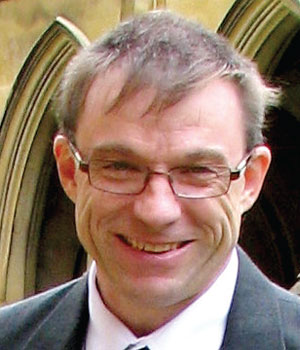Richard Bale - 2015
CSEG Technical Achievement Award Citation for Richard Bale
Citation by Rob Kendall and Jim Gaiser
 For Notable Contributions to the Field of Multi-Component Seismic
For Notable Contributions to the Field of Multi-Component Seismic
Richard Bale is receiving the Technical Achievement Award this year for his significant contributions in multicomponent research. He holds both a BA and an MA in mathematics from the University of Cambridge in the UK, and obtained a Ph.D. in geophysics from the University of Calgary in 2006. Richard received the award for outstanding Ph.D. thesis in Geology and Geophysics for his dissertation on elastic wave-equation depth migration of split shear-wave (S-wave) data in azimuthally anisotropic media.
Richard began his geophysical career with GECO in the UK in 1984, and continued with Schlumberger Geco-Prakla, in both the UK and Norway, as a senior research geophysicist. From 1997 to 2001 he was project manager for multicomponent processing development for Geco-Prakla and WesternGeco, responsible for software used to process 4C data in the North Sea and Gulf of Mexico. He moved to Calgary in 2001, and after receiving his Ph.D. worked for Veritas/CGGVeritas from 2004 to 2011, and then for Key Seismic Solutions Ltd where he is currently Vice President Research and Development.
In addition to his advanced research on imaging S-waves in birefringent media, Richard has authored or co-authored a number of SEG, EAGE and CSEG papers on two important aspects of multicomponent processing. In particular, his papers Whale and Bale et al., 2009 and Bale et al., 2009 not only provide excellent tutorials on shear-wave splitting but show that accounting for birefringence in heavy oil datasets leads to a step change in converted-wave (PS-wave) data quality. After overburden corrections are made, high-resolution fracture and stress properties are obtained at target levels. These data correlate with borehole log information and are extremely useful for reservoir monitoring.
Another area of Richard’s innovative research addresses the challenging asymmetric properties of PS-waves, where he has demonstrated the essential properties that govern common-offset vector data. Utilizing wavefield VP/VS, conventional 3D geometries can provide uniform illumination for improved imaging and other applications beneficial for S/N enhancement and joint inversion with P-waves.
Richard’s contributions to the geophysical community also go beyond volunteering as an Associate Editor for the SEG. He has been influential in promoting multicomponent technology throughout his career in a world-wide sense, and has co-taught the DoodleTrain multicomponent course for nine years in the Canadian market. Richard is clearly a deserving recipient of the 2016 Technical Achievement Award.




